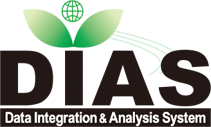Newly published datasets this year so far
Five new datasets have been released so far this year. Here is a brief introduction.
- Typhoon DDS dataset for changing climate
It is the high-resolution dataset focusing on typhoons that can affect Japan. It was created by the dynamical downscaling (DDS) using a high-resolution non-hydrostatic regional model called "CReSS" developed at Nagoya University. This dataset includes the results of past and projected experiments. - Global crop phenological events of major crops
It is the global dataset with estimated likelihoods of phenological event occurrence timing for major cereals at a spatial 0.5° resolution.
The daily likelihoods of the occurrence of crop phenological events, such as average dates of sowing, emergence, maturity, and harvesting for maize, rice, wheat, and soybean around the year 2000, are available in the dataset. - 150-year continuous simulation with 60km AGCM and 20km NHRCM by TOUGOU program
It is the dataset simulated by a 60km-grid high-resolution global atmospheric model (AGCM) and dynamical downscaling to the Japanese region using a 20km-grid regional climate model (RCM).
These continuous high-resolution simulations enable us to estimate, for example, how meteorological events change from the past to the end of the 21st century. - Bias corrected climate scenarios over Japan based on CDFDM method using CMIP5, and Bias corrected climate scenarios over Japan based on CDFDM method using CMIP6
This dataset is bias-corrected climate scenarios over Japan with a spatial 1km resolution from the CMIP5 4GCM and CMIP6 5GCM historical and several future projection scenario experiments. It contains eight variables (daily minimum, maximum, average temperature, precipitation, total solar radiation, downward longwave radiation, wind speed, and relative humidity) daily from 1900 to 2100.
Four datasets above, except for "Global crop phenological events of major crops," will be a part of the upcoming "Climate Change Projection Dataset 2022".
For details and downloads of each dataset, please refer to each metadata from the links above.

